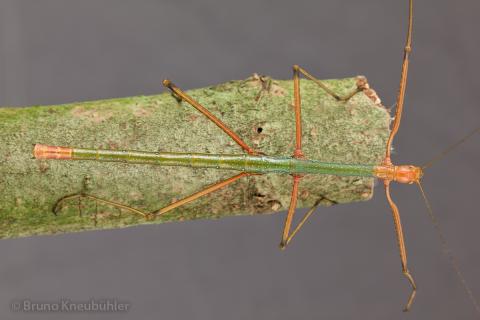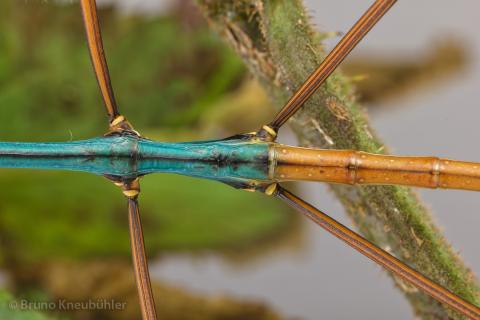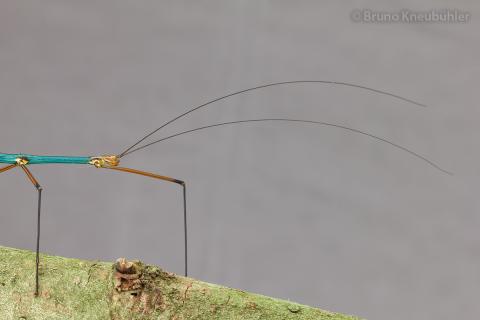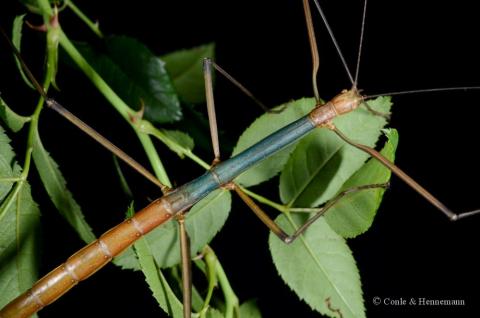
Genus
Species
Stock
CLP
572
PSG
336
Culture status
In culture
Foodplants
Bramble (Rubus spp.)
Firethorn (Pyracantha)
Hazel (Corylus avellana)
Beech (Fagus sylvatica)
Hypericum spp.
Breeding notes
(by Bruno Kneubuehler)
General Notes
- 2011 – taxonomical aspects of this species are being examined by
Joachim Bresseel (Belgium), and he will also describe this species - 2012 - first successful culture by Bruno Kneubuehler
- 2012 - this species has been distributed as Lopaphus sp. "Cuc Phuong"
_________________
Origin
- Cuc Phuong, Vietnam
_________________
Females
- very nice, medium sized phasmids
- about 9.5 – 10.5 cm long
- there are two very different color morphs amongst the females
- first morph has a blue meso- and metathorax, brown legs, head, prothorax, abdomen (dorally), black areas and a green abdomen (ventrally)
- second morph has a olive-green meso- metathorax, abdomen; reddish-brown head, prothorax, legs
- both color morphs have numerous light or white dots on the thorax and abdomen (dorsally)
- antennae are longer than the forelegs
- no wings (apterous)
_________________
Males
- very beautiful, thin phasmids
- coloration is consistent amongst males
- about 7.5 – 8.5 cm long
- strongly blue meso- and metathorax
- thorax and abdomen (dorsally) with numerous, fine light or white dots
- legs and abdomen are reddish-brown
- antennae much longer than the forelegs
- no wings (apterous)
_________________
Nymphs
- about 14 mm (L1)
- green (L1)
- as soon as the nymphs start to feed, they become darker green in color
- by L3, most nymphs are brown-green with many white dots
- rather hairy legs and antennae
- antennae already longer than forelegs
- by L3 it is quite easy to draw a distinction between ♀♂ (by the naked eye)
_________________
Eggs
- small
- about 2 x 1.5 mm
- elongate-oval
- brown
- matt
- surface is net-like structured
- capitulum is distinctly raised from the egg lid (operculum)
- micropylar plate is well visible
_________________
Food Plants
- bramble (Rubus sp.)
is very well accepted by freshly hatched nymphs, older nymphs and adults - bramble (Rubus sp.) - fresh leaves in spring
is very well accepted by adults (not tested on nymphs) - firethorn (Pyracantha sp.)
is very well accepted by freshly hatched nymphs (not tested with older nymphs and adults) - hazelnut (Corylus avellana)
is very well accepted by adults (not tested with nymphs) - beech (Fagus sylvatica)
is well accepted by adults and older nymphs (not tested with young nymphs) - Hypericum
preferred over bramble (info: Andreas Rolke)
_________________
Behaviour
- nymphs as well as adults behave VERY frantically when tthey feel threatened. Often many will fall to the ground and wriggle about frantically when one is changing the food plants
- thus it is best to avoid touching them – as far as possible
- rather active also during the day – thus this species is also great for displays
- matings are frequent – day and night
- males do not stay with the same female for a prolonged time
_________________
Developement
- incubation time (HH-incubation on slightly damp sand at 20 - 23 °C) is about 5 months (F1)
- spread some dried (!) moss over the eggs - this will make it much easier for the nymphs to hatch unscathed and it also reduces mould growth to some extend
- hatching ratio in F1 was very high (> 50%)
- males will be adult after about 3.5 months (at 20 – 23°C), females after about 4 months
- females start laying eggs after about 2 – 3 weeks
- eggs are flinged away with a swing of the abodmen
- about 35 – 45 eggs per female and week
- adults can live for several months
_________________
Breeding Notes
- my general notes on how to breed phasmids are a integral part of this care sheet ...
- it is very easy to breed this species
- keep the nymphs in a cage with good ventilation, but take care that the humidity does not drop too low
- a constantly wet paper towel on the floor of the cage helps raising humidity
- a humidity level of about 65 % rH seems to be sufficient (no problem if higher)
- nymphs can be kept in a Faunabox (or similar cages)
- move nymphs to a bigger cage as they grow bigger
- a cage of at least 30 x 30 x 30 cm should be provided for 3 - 4 couples of this species (or considerably larger if the cage also contains other species !)
- generally I advise to keep different phasmid species seperately (unfortunately, overcrowed cages are still very common ...)
- I have never sprayed nymphs or adults (or their cage) with water
- make shure that nymphs, which are about to undergo their adult moult, do not find places in the cage which would not offer them enough space beneath to moult successfully






































































